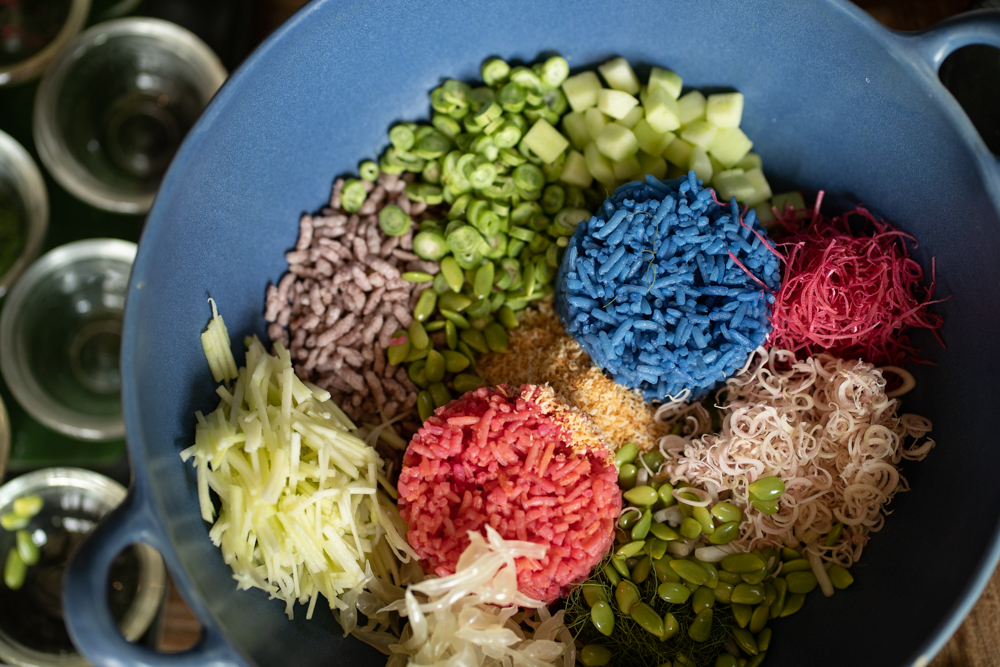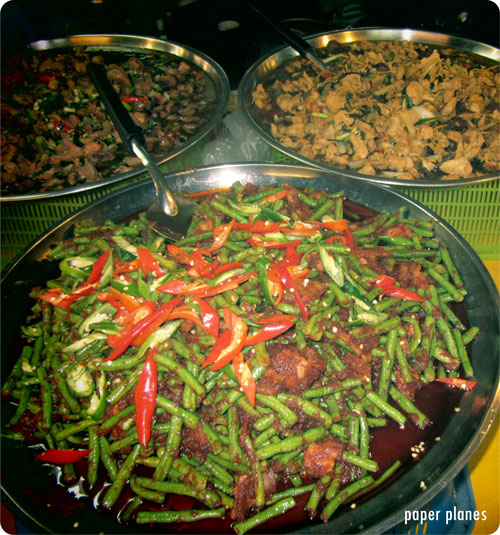
Tastes of Thailand
Thailand has arguably some of the best food in the world – the ingredient and flavor combinations are unique and enticing. Add to that the ability to find high quality, fresh, affordable dishes throughout the country – about $1 for a full plate cooked to order – and Thai food becomes pretty hard to beat.
While I absolutely adore Thai food and continue to try as many new, and sometimes strange, things that are put in front of me, I haven’t written much about it. It’s overwhelming. There are a handful of dishes known worldwide – phad thai, green curry, etc. – that are wonderful stand bys, but once you get past the familiars, another world of flavors, options and combinations opens up that seems never ending (just take a look at the gorgeous She Simmers blog on Thai home cooking – she bypassed stir fried cashew nut with chicken and papaya salad long ago). I’ve eaten simple, clear broth soups with tofu and seaweed, sour and spicy Thai relishes eaten with cucumbers and eggs, desserts of ice, coconut milk and jelly. I’ve learned to pick out the cheeks on a fried fish with chili sauce, eat sticky rice and pork for breakfast, and sour green mango with crushed chilies.
All Thai dishes are supposed to have a mix of sweet, spicy, salty and sour flavors. Papaya salad, for example is made with palm sugar, crushed fresh chilies, salty dried shrimp and lime juice – sweet, spicy, salty, sour.
The attention paid to these combinations, and how the flavors end up working together, is one of the reasons why Thai food is so special.
For me, I can break it down even further, and pick out the particular ingredients that I will now always associate with Thailand wherever I am.
LEMONGRASS – Used in soups, grilling and tea, lemongrass has a unique, medicinal lemony flavor. The smell and taste is especially apparent in soups like tom yum koong and tom kha.

Tomatoes, corn, ginger and lemongrass
COCONUT – Young fresh coconuts for drinking, thick coconut cream sauce drizzled over mangoes with sticky rice, tom kha soup using coconut milk as a base – coconut is everywhere.

PANDAN – Pandan leaves are used throughout southeast Asian cooking for flavoring or coloring. The leaves are steeped in water and often added to desserts, like mango and sticky rice, custards and jellies. Sometimes you’ll see green noodles or breads that have been colored by the super green leaves. While the flavor isn’t very strong, it’s softly sweet, like a gentle mix of coconut and vanilla, without becoming too heavy or sweet.
FRESH CHILIES – I love spicy food and am proud to say I can eat ‘Thai spicy’ – although usually, even if I say I want a dish spicy, it’s still dumbed down for my weak, farang (foreign) tongue. I put dried, crushed chilies on most of my food, especially stir-friend dishes and noodle soups. However, the fresh chilies will be what stick with me long after I ever leave Thailand. They’re harsh, raw, stingingly spicy and used liberally – from fish to Thai salads. Driving down the street you’ll sometimes have your breath suddenly caught in your throat as you get a whiff of chilies sizzling in hot oil. It’s horrible and wonderful at the same time.

FISH SAUCE – I can understand why some people may not like fish sauce – sometimes it can overpower a dish and if you have a sensitive nose – especially in hot, humid Thailand – it can put you over the edge. It’s salty and fishy, and has a very distinct smell that immediately lets you know it’s…salty and fishy. I, however, love it. I never used fish sauce at home, but it’s so pervasive throughout Thai cooking that I will now always associate it with Thailand and Thai food. While it’s used in just about everything, I’ll then add more prik naam bplaa, fish sauce with crushed fresh chilies, on most plates put in front of me. I’m not a soy sauce fan, but give me some fish sauce and I’m a happy girl.
THAI BASIL – There are three types of basil that are commonly used in Thai cooking. What’s known in English as ‘Thai’ basil has narrow leaves, purple stems and smells slightly sweet, almost like licorice. The flavor is distinctly different than the basil we would use at home in pastas or pizza.

LIME – One of my students asked me what my favorite fruit is and I said limes. She was a little confused, but I think lime makes everything better – lime juice brings out the flavors of a fresh papaya, balances the spiciness of a tom yum koong and is used in the only two cocktails I’ll drink – mojitos and margaritas. Lime is is widely used to add the sourness to the Thai taste mix and you can usually buy 4 or 5 limes for 10 baht, or about 35 cents. Kaffir lime leaves are used for flavoring in soups and curries and you’ll see the kaffir limes themselves at spas and massage places added to warm water for foot soaks.

What flavors remind you of a certain place? Let me know in the comments!
Hey! I'm Alana and I've spent nearly the past decade living in Chiang Mai, Thailand, working as a writer and photographer. I started Paper Planes as a place to share local insight, special places, and how to travel well through a range of experiences — from hostels to high-end hotels, street meat to multi-course meals.
New places are always calling my name...
2/11/13
Leave a Reply
let me join you in your inbox
Enter your email for a taste of different worlds, must-read posts, and special offers.
(Don't worry, I'll never spam you — just send the good stuff.)


New Mexican red and green chilies – as addictive and evocative as Thai:)
my goodness these photos basically just made me drool. I found your blog through drew meyer’s recent post, and i was telling him how much i want to go to thailand for this very reason!
Do it! Although, be aware that once you make it over here you may not leave 😉
beautiful photos! I really want to go to a Thai cooking school when I finally get to SE Asia… do you know of a good one? Thanks!
Chiang Mai is a definite hub for them – most in town offer about the same program (day or half day, similar recipes and process) and are relatively the same price. While they’re all similar, I haven’t heard of anyone having a really poor experience, I would recommend the Chiang Mai Thai Farm Cooking School. There are also several farm-stay/cooking course options outside of town in the surrounding area…depends on what you’re looking for!
Thanks for this article. Now I can’t wait for my trip even more 🙂 Going in 24 days
You’ll love it! Try to find someone who knows the area you’re in to suggest where to go eat – I’ve been in Chiang Mai for more than a year and a half and still am having people recommend places I didn’t know about…
Wow, everything sounds amazing! I clearly need to be more adventurous in my Thai food choices (although it still wouldn’t compare with actually visiting Thailand. maybe that will be next on my list after my European trip).